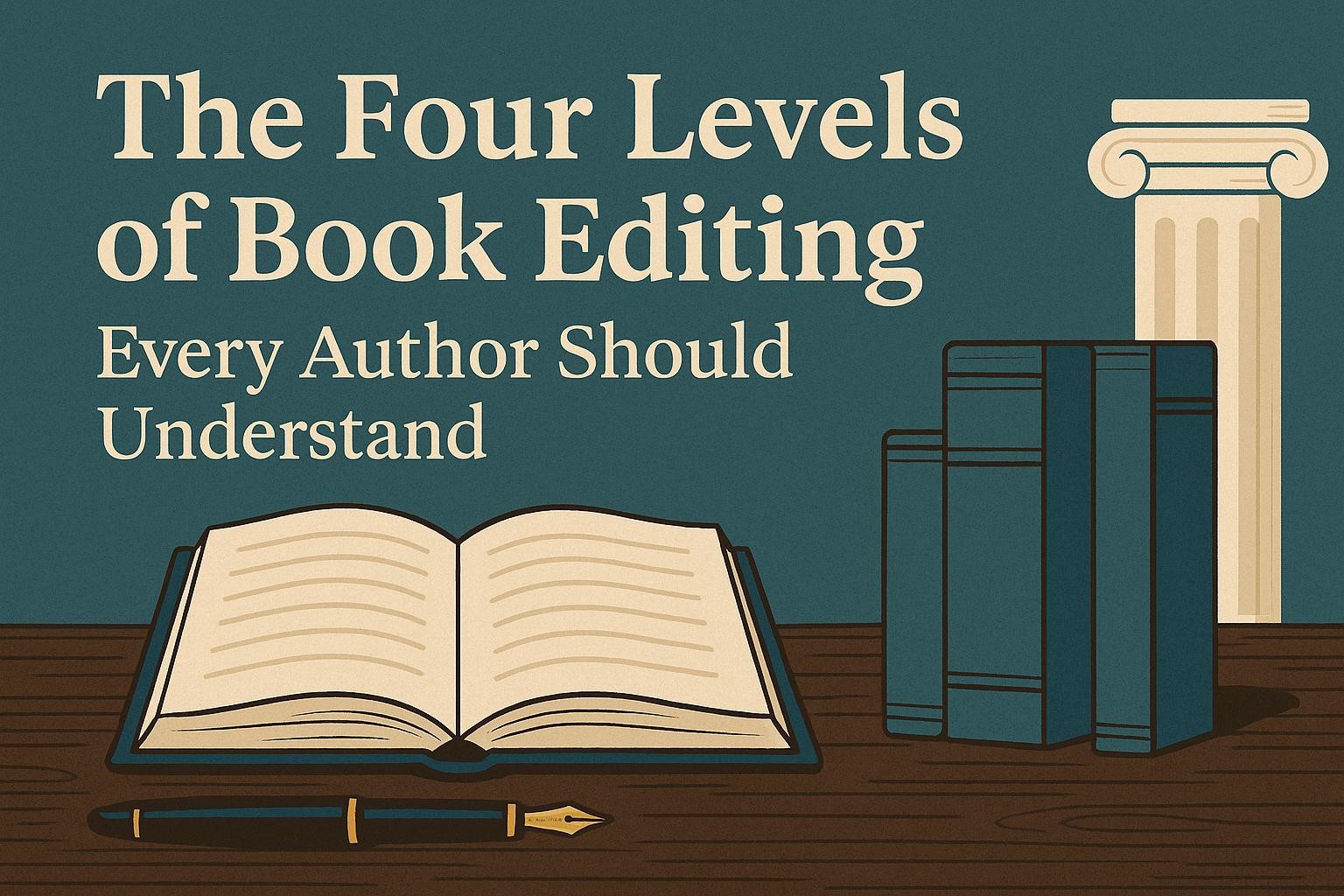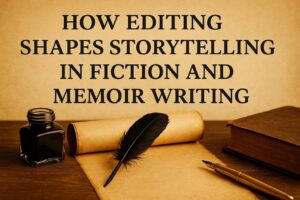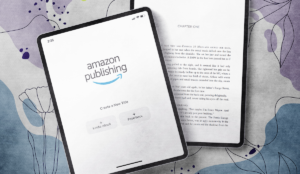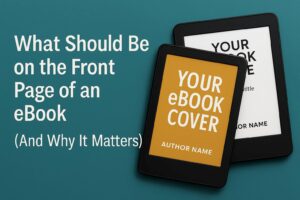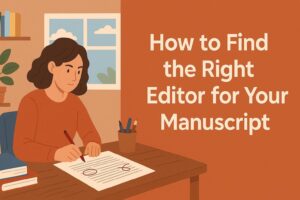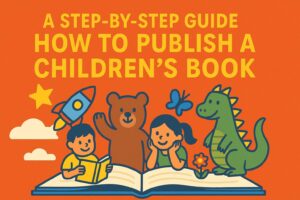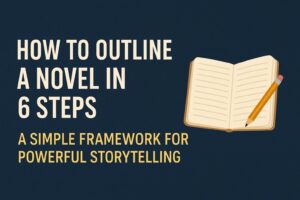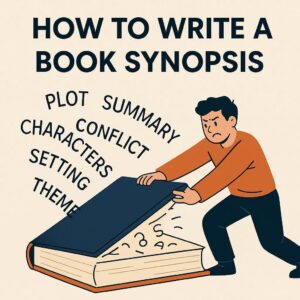Master the art of editing with this complete guide to the four levels of book editing; developmental, line, copyediting, and proofreading. Learn what each stage involves, when to hire, and how to prepare your manuscript to save time and costs.
Introduction
You’ve finished your draft. You’re exhausted, proud, a little dizzy. You’ve climbed the mountain of words and now you’re standing at the edge, staring into the next abyss: editing.
And suddenly, everyone has advice.
“Get a proofreader.”
“No, you need a copyeditor first.”
“Skip straight to line edits, developmental comes later.”
It is noise. Confusing, contradictory noise. And if you’re like most writers, you’re thinking: I just want to make my book the best it can be without wasting money or time.
Here’s the truth: editing does not happen in one giant sweep. It happens in layers. Stages. Four distinct levels of book editing that move from the big, structural issues all the way down to the last sneaky typo. Miss a step and you will either burn cash or publish a book that was not ready.
I have been in that fog before. I know what it feels like to want clarity, a roadmap, a voice saying: Here is the order, here is why it matters, here is how to choose what you need.
That is what you will get here. By the end, you will not only know the four levels, you will know exactly which one fits your manuscript right now.
Why Editing Happens in Levels
Editing is not one giant sweep
You cannot take a draft, hand it to someone, and expect them to fix everything in one pass. Editing has to move in a sequence. Big picture first. Then language and clarity. Then grammar and style. Only at the very end do you worry about polishing every comma and spotting the stray typo.
Trying to do all of this in one round is like trying to rebuild a house while painting the walls. You cannot pick colours until the foundations are secure. The same logic applies to books.
The staged workflow
Editors often talk about the four main levels of editing. Each stage zooms in a little closer, shifting from the wide view of your story to the microscopic detail of your punctuation. This progression matters.
If you focus on surface errors before fixing the core structure, you will waste money. Scenes might still need cutting. Characters might still need reshaping. That proofread you paid for will be useless because whole paragraphs might get rewritten later.
The danger of skipping steps
Many writers want to skip straight to the end. They want professional proofreading services right away because it feels safe, contained, and affordable. But proofreading is not meant for early drafts. It is the final polish, not the deep surgery. If you rush into it, you will miss the problems that actually stop a story from landing with readers.
From big to small
The levels unfold in a clear order:
- Developmental editing looks at the bones of your book. Are the chapters in the right place? Is the pacing dragging? Are your characters believable?
- Line editing comes next. Here, the focus is on how sentences flow. The editor checks rhythm, voice, and clarity.
- Copyediting zooms in further. Grammar, punctuation, usage, and consistency all come under the microscope.
- Proofreading is the very last step. This is the eagle-eyed hunt for typos and layout issues before you publish.
Why the order matters
Every stage assumes the stage before it is complete. That is why developmental editing comes first. You cannot polish sentences if entire chapters still need to move. You cannot copyedit if your style is still shifting. And you definitely cannot proofread if your text is not yet stable.
Think of it as building trust with your future readers. Each step makes your book more solid. By respecting the order, you save time, cut costs, and ensure the final version has both strength and shine.
Level 1: Developmental Editing
The big picture stage
Developmental editing is where the real heavy lifting begins. This is the stage that asks the hardest questions. Does your story actually work? Does it keep a reader hooked? Are the themes clear? Is the structure strong enough to carry the weight of your ideas?
If the answer to any of these is shaky, this is where you fix it. Forget about commas or clunky sentences for now. At this level, the focus is on story architecture, pacing, plot holes, and overall cohesion.
What you actually receive
When you hire an editor for this stage, you do not just get a few tracked changes in the margins. You usually receive an editorial letter that can run anywhere from five to twenty pages. Alongside it, you will see in-document comments pointing out weak scenes, character inconsistencies, or chapter flow problems. Sometimes you will also get a revised outline or even a call with the editor to walk through the changes.
When to do it
This is the stage to consider right after you have a complete draft. Not an idea. Not three chapters. A full draft from beginning to end. Even if it feels rough, the book needs to exist in full before anyone can judge its bones. If you dive into line or copyediting first, you will waste money because entire chapters could be rewritten after this process.
Typical deliverables
- An editorial letter with big picture notes
- Margin comments for specific scenes
- A reshaped outline if the structure needs major work
- Sometimes multiple rounds of feedback
Why it matters
Think of developmental editing as the equivalent of a structural engineer inspecting a bridge before cars drive across. The bridge might look nice, but if the support beams are weak, it will collapse under pressure. In the same way, your manuscript might have pretty sentences, but without strong structure, it will not hold a reader.
Writers often get confused about developmental editing vs copyediting. The difference is huge. Developmental looks at story and structure, while copyediting looks at correctness and consistency. Mixing them up leads to frustration and wasted budget.
Level 2: Line Editing
The craft of the sentence
Once the foundation of your book is solid, it is time to zoom in closer. Line editing is about the artistry of language. This is where an editor looks at the rhythm of your prose, the clarity of your sentences, and the consistency of your voice.
Think of it as tuning an instrument. The notes are already written, but now they need to sound right together. A line edit makes your writing sing.
What you actually receive
This stage can feel intense because your manuscript often comes back drenched in tracked changes. An editor will suggest rewrites, rephrasings, and adjustments to imagery. They will point out clunky transitions and highlight where your voice drifts out of tune. You also get style notes that explain the reasoning behind their changes so you can learn from them.
When to do it
Line editing comes after the developmental stage. By this point, your structure should be firm. Characters are where they belong, chapters are in the right order, and scenes are locked in. Now the focus shifts to how well those scenes read on the page.
Typical deliverables
- Heavily marked manuscript with tracked changes
- Notes on tone, imagery, and voice consistency
- Suggestions for smoother transitions between paragraphs and chapters
Why it matters
This is often the stage that transforms clunky drafts into professional-quality prose. It is not about nitpicking grammar. It is about whether your words feel alive, whether your descriptions land, whether your dialogue flows with authenticity.
Many authors confuse line editing with copyediting because both work at the sentence level. The difference is purpose. Line editing shapes beauty and clarity. Copyediting enforces correctness and rules. Together, they cover two very different types of editing in books.
Level 3: Copyediting
The polish of correctness
Once your story works and your sentences flow, copyediting takes over. This stage is not about rewriting scenes or fine-tuning imagery. It is about making sure the text is correct, consistent, and professional. A copyeditor is the guardian of rules and standards. They are the person who spots the missing comma, the misused word, the style inconsistency that distracts readers.
Copyediting may not feel as dramatic as a developmental edit, but it is essential. Readers notice mistakes. Typos, inconsistent character names, and incorrect grammar pull them out of the story. If line editing is music, copyediting is the tuning fork that ensures every note is in key.
What you actually receive
A copyedit comes back as a tracked document where corrections are made directly in the text. You will see commas adjusted, words shifted, and grammar corrected. Alongside this, you receive a style sheet. This is a document that tracks all your spelling decisions, hyphenation choices, capitalisation rules, and specific terms unique to your book. For example, if your fantasy novel uses “grey” instead of “gray” or capitalises the word “Order” for a magical group, the style sheet makes sure those decisions are applied consistently from start to finish.
Some copyeditors also make light line edits where necessary. They may rephrase awkward sentences if the meaning is unclear, but their primary task is accuracy and adherence to the agreed style guide, such as the Chicago Manual of Style.
When to do it
Copyediting comes after line editing. By this stage, the prose is locked in place. You are not moving chapters or rewriting dialogue. The creative choices are set. Now it is about ensuring that what you have written is correct and consistent.
Typical deliverables
- A tracked document with all grammar and usage fixes
- A style sheet that records decisions on spelling, hyphenation, and terminology
- Notes where clarity issues or factual questions arise
Why it matters
Skipping copyediting is a gamble. Even the strongest writers miss errors in their own work. A fresh set of trained eyes will always catch mistakes you did not see. And when readers encounter too many errors, they begin to doubt the quality of the book as a whole.
Think of the four levels of book editing as a ladder. Developmental editing gave you the structure. Line editing gave you the style. Copyediting gives you correctness. Each step builds on the last, and by the time you reach this one, your manuscript should be close to professional quality.
Copyediting is where a draft stops looking like something you wrote alone and starts looking like something ready for readers.
Level 4: Proofreading
The last defence
Proofreading is the final stage of editing. By the time you arrive here, the structure is set, the sentences flow, and the grammar is correct. What remains are the smallest surface errors that can still slip through: a missing period, a repeated word, or a typo that escaped notice in earlier stages. Proofreading is the last defence before your book goes out into the world.
What you actually receive
Proofreaders usually work on a PDF or galley version of your book, not a Word document. This matters because they are not only checking words. They are also scanning the layout itself. Page numbers, spacing, headers, and even awkward breaks like widows and orphans (where a single word is stranded at the top or bottom of a page) are all caught here.
The deliverable is a marked-up proof, either with digital comments or a list of corrections keyed to page and line numbers. At this stage, the changes are minor, but the impact is huge. A single typo can jolt a reader out of immersion, and too many errors can make a book feel rushed or unprofessional.
When to do it
Proofreading always comes after copyediting and typesetting. It is not a replacement for deeper editing. A proofreader will not tell you if a scene feels weak or if your dialogue drags. Their job is to sweep the final surface, not to reshape the house beneath. If you try to skip earlier steps and jump to proofreading, you will waste money because the text is still unstable.
Typical deliverables
- A marked PDF or proof copy with corrections
- Notes on layout issues such as spacing or page breaks
- A final checklist of typos, punctuation errors, and formatting inconsistencies
Why it matters
Readers rarely notice when a proofread is done well. They notice when it is skipped. That is the invisible power of this stage. A proofreader makes sure your book feels smooth, polished, and trustworthy. The smallest detail can make the difference between a book that feels amateur and one that feels professional. Many authors discover this stage through book editing services that package all four levels together. Whether you buy them as a bundle or individually, proofreading should never be ignored. It is the last polish before your book stands in front of its audience, and it is what ensures all the work you put into the earlier stages shines without distraction.
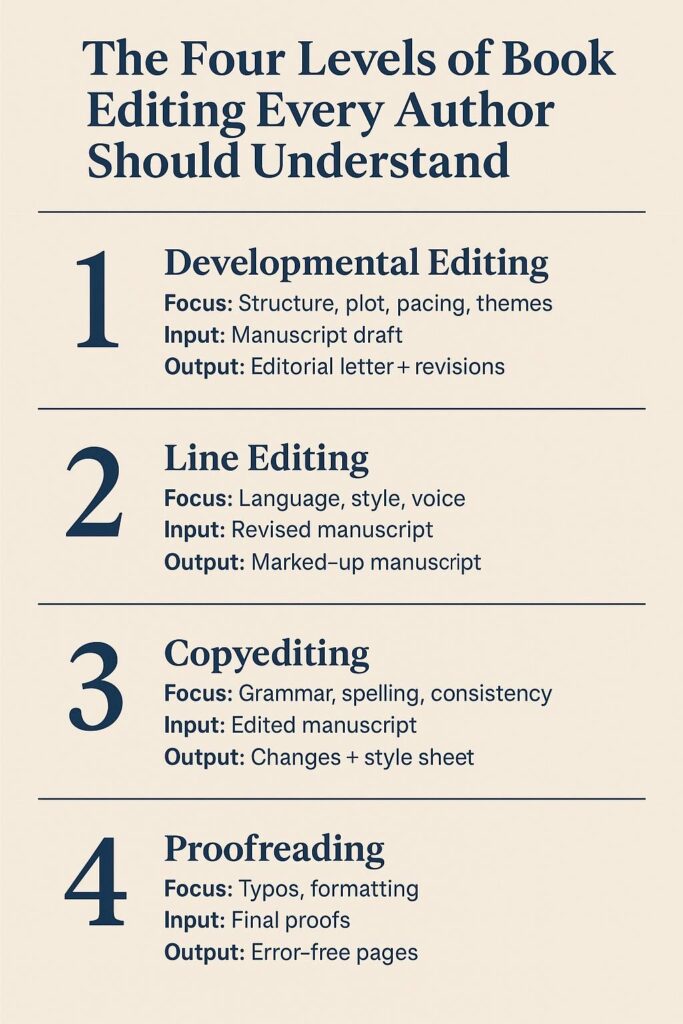
Putting It Together: The Standard Sequence
Why order matters
Editing is not a free-for-all. There is a reason professional editors follow a sequence. Each stage prepares the ground for the next, and if you skip ahead, you risk wasting time, money, and energy. Imagine baking a cake: you cannot frost it before the sponge is baked, and you cannot bake it if the batter has not even been mixed. The same principle applies here.
The natural flow
The standard editing sequence looks like this:
- Developmental Editing
- Line Editing
- Copyediting
- Proofreading
This order moves from the widest lens to the narrowest. First, you deal with the bones of the book. Next, you refine the craft of the sentences. Then, you enforce correctness and style. Finally, you sweep away the lingering surface errors.
What happens if you skip
Skipping levels often leads to frustration. For example, if you go straight to proofreading when your chapters are still shaky, you will end up paying for corrections that become irrelevant once you rewrite. If you try to copyedit before line editing, you may polish sentences that later get rephrased for flow and voice.
This is why developmental editing vs copyediting is such an important distinction. One is about deep structure, the other about fine detail. Mixing them up creates confusion, not clarity.
How the sequence protects you
Following the order has two huge benefits:
1. It saves money.
When you edit in sequence, you do not pay someone to polish text that is not ready. Each round builds on the previous one, so no work is wasted.
2. It builds confidence.
As you move through each stage, you know the manuscript is getting stronger. By the time you reach proofreading, you are not wondering if the plot makes sense or if your voice wavers. You know those issues have already been handled.
The domino effect
Think of editing like lining up dominoes. If one falls out of place early, every piece after it will topple crooked. Developmental edits set the foundation. Line edits adjust the flow. Copyedits tighten the details. Proofreading ensures nothing distracts from the final picture. Take one domino out of the chain, and the rest will not stand the way you want.
A map for every author
Some writers will need all four levels. Others may only need the later stages if their draft is already in strong shape. Budget also plays a role. But even if you cannot afford every step, understanding the sequence helps you make smarter choices. If you must cut corners, at least you know what you are sacrificing and where the risks lie.
The bottom line
The editing sequence is not arbitrary. It is the roadmap that takes a messy draft and turns it into a polished book. Respect the order, and you give your story the best chance of reaching readers the way you intend. Ignore it, and you risk releasing something unfinished into the world.
What Level Do You Need Right Now?
Not every manuscript is the same
One of the biggest mistakes writers make is assuming every book needs the exact same editing path. The truth is, where you are in your draft determines what kind of help will move you forward. Some manuscripts are still rough skeletons that need structural surgery. Others are polished but littered with grammar slips. The right edit depends on the state of your book right now.
Spot the signs
Here are common “symptoms” and what they point to:
- “My beta readers are confused about the middle.”
That signals a need for developmental editing. The bones of the story need work. You might need to re-order chapters, cut scenes, or rethink pacing. - “The story feels set, but the writing reads clunky.”
That is a classic case for line editing. The structure is sound, but the sentences need life, rhythm, and clarity. - “My voice is consistent, but I know there are grammar mistakes.”
Now you are looking at copyediting. The creative work is done. It is time for correctness and consistency. - “The book is laid out, and I just want to make sure no typos remain.”
This is the right moment for proofreading. Nothing deep will change at this stage, only the surface errors.
Why this matters
Choosing the wrong level wastes resources. If you go for proofreading too early, whole sections of text may still be rewritten, which means every correction made will vanish with the cut. If you pay for line editing before fixing story structure, you will polish sentences that could end up deleted.
The four levels of book editing exist for a reason. They are not arbitrary labels but a practical sequence that saves you from throwing money at the wrong problem.
Trust the process
Instead of guessing, step back and ask: What feels unfinished in my draft? Is it the story itself, the way the sentences read, the correctness of the grammar, or the final polish? Your honest answer points directly to the stage you need.
Every writer wants to believe their book is closer to the finish line than it is. But clarity here is not about pride. It is about getting the right support, at the right time, so your book becomes the version readers deserve.
Deliverables and Editor Expectations by Level
Developmental Editing
This is the stage where you get the most feedback in bulk. Expect an editorial letter that can run anywhere from five to twenty pages, packed with notes on structure, pacing, character arcs, and themes. You will also see margin comments throughout the manuscript, pointing out specific weak spots or questions. Many editors also provide a reshaped outline so you can see how your book might flow differently. Some offer a follow-up call to walk through the feedback, and a few even include a second look after revisions.
What to expect:
- A deep analysis of your book’s structure
- Comments on story, characterisation, and pacing
- A roadmap for revisions
Line Editing
Here you will see the most tracked changes in the actual manuscript. A line edit digs into every paragraph and sentence. The editor will rephrase awkward lines, suggest sharper word choices, and highlight where your voice drifts or where the rhythm falters. They will also provide notes on tone, transitions, and consistency of style.
What to expect:
- Tracked changes throughout the text
- Notes on voice, imagery, and clarity
- Paragraph-by-paragraph suggestions for flow
Copyediting
This stage is more precise. The copyeditor will return a document where grammar, punctuation, usage, and consistency have been corrected. Alongside this, you receive a style sheet that records every important decision: spellings, capitalisation, hyphenation, and unique terms in your manuscript.
What to expect:
- Tracked corrections for grammar and consistency
- A style sheet to ensure uniformity
- Occasional comments where clarity is in question
Proofreading
At this final stage, you should not expect big changes. Proofreaders mark up a PDF or proof copy with minor corrections. Their focus is on typos, punctuation slips, and layout issues like widows, orphans, and broken headers.
What to expect:
- A marked-up PDF or annotated proof copy
- Notes on layout and formatting issues
- A final clean sweep of surface errors
Names and Overlap: Why Terminology is Confusing
Different editors, different labels
One of the most frustrating parts of hiring an editor is the language. What one editor calls a line edit, another might label a “stylistic edit.” Some group line editing and copyediting together. Others split developmental editing into two separate services: a lighter “editorial assessment” and a full structural edit.
This overlap is not about trickery. It is usually about tradition, training, or regional practice. Editors working in the UK may use different terms than those in the US, even when they are essentially offering the same service.
Why this matters for you
The confusion can make it hard to compare quotes or choose the right person for your project. Two editors might describe their service in completely different ways, yet both could be talking about the same type of editing in books. That is why clarity of scope is critical.
How to protect yourself
Instead of relying only on labels, look closely at the description of what the editor will actually do. Ask:
- Will they look at story structure?
- Will they work at the sentence level?
- Are they focused on grammar and consistency?
- Will they only be correcting typos?
When you know exactly what you are paying for, the terminology matters less.
The takeaway
Do not assume your editor’s definition matches what you have read online. Always ask for a clear breakdown of the tasks included in their service. That way, you will know whether the work fits the stage your manuscript needs right now.
Pricing, Timing and How Editors Quote
Why costs vary
One of the first shocks for new authors is the price of editing. Quotes can look wildly different from one editor to the next. The reason is simple: the cost depends on the level of editing, the length of your manuscript, and how “clean” the draft is. A rough draft with tangled sentences will take far longer to line edit than a polished manuscript that only needs a light touch.
How editors usually charge
Most editors quote by word count. For example, you might see a rate of two cents per word for copyediting or a higher per-word rate for line editing because of the deeper work involved. Some editors charge by the hour, but word-based pricing is far more common since it gives you a predictable total cost.
Typical ranges
It is impossible to give one-size-fits-all numbers, but you can expect developmental editing to be the most expensive because it requires the most analysis and time. Line editing also sits on the higher end due to its detail. Copyediting costs a bit less, and proofreading usually falls at the lowest end of the scale since it is the quickest stage per word.
How long it takes
Timelines also vary. A developmental edit can take weeks or even months, especially if it involves multiple rounds. Line edits often take a few weeks depending on the word count. Copyediting is usually faster, and proofreading is the quickest stage of all. Rush jobs are sometimes available, but expect to pay a premium.
Getting accurate quotes
When you contact an editor, expect to share:
- Your total word count
- The level of editing you think you need
- A sample of your manuscript
Many editors will offer a short sample edit. This shows you what kind of feedback they provide and helps them gauge how much work your manuscript requires. It also ensures you know what you are paying for before committing to the full project.
The takeaway
Costs and timing always depend on scope. The more complex your manuscript, the longer and more expensive the edit will be. Comparing quotes without context can be misleading, so focus less on the labels and more on the actual work included in the service.
DIY Prep to Reduce Costs Before You Hire
Why self-prep matters
Hiring an editor is an investment, and the cleaner your draft, the less time they need to spend on obvious issues. That means lower costs for you. Think of it like handing your car to a mechanic. If you have already topped up the oil, pumped the tyres, and replaced the wiper blades, the mechanic can focus on the real repairs. The same principle applies to editing.
Start with clarity
Before you send your manuscript off, make sure you know what your book is really about. Can you summarise the central theme or argument in one or two sentences? If not, tighten your focus. Editors can guide you, but if your core vision is too foggy, developmental edits will take longer and cost more.
Fix the obvious
Every draft has easy-to-spot issues that you can handle yourself. Look for plot holes, dangling subplots, or characters that vanish halfway through. Clean these up before an editor has to spend hours flagging them. Run a spell check. Correct repeated words. Catch the small errors now and save the editor’s time for higher-value work.
Use a style guide
Pick a standard like the Chicago Manual of Style or AP Style and apply it yourself. Decide early on whether you will spell it “grey” or “gray,” whether you will hyphenate “well-being” or not, and whether your fantasy kingdom capitalises every title. Consistency saves your editor from chasing basic decisions and lets them focus on polishing the manuscript.
Check your names and terms
Proper nouns, invented languages, and specialised terminology are fertile ground for mistakes. Create your own list of names, places, and terms with consistent spelling. That way, when your editor builds a style sheet, they will have a head start.
Run a self-edit pass
Read your work aloud. Awkward phrasing leaps out when spoken. Tighten sentences. Cut filler words. Rearrange clunky dialogue. The closer your manuscript gets to readable prose, the less heavy lifting your editor needs to do.
The payoff
The four levels of book editing exist to protect your book and guide it step by step toward publication. But you can lighten the load by doing your part before handing the draft over. Every fix you make on your own is one less correction on the invoice. More importantly, it shows your editor you take the process seriously, which often leads to a stronger partnership.
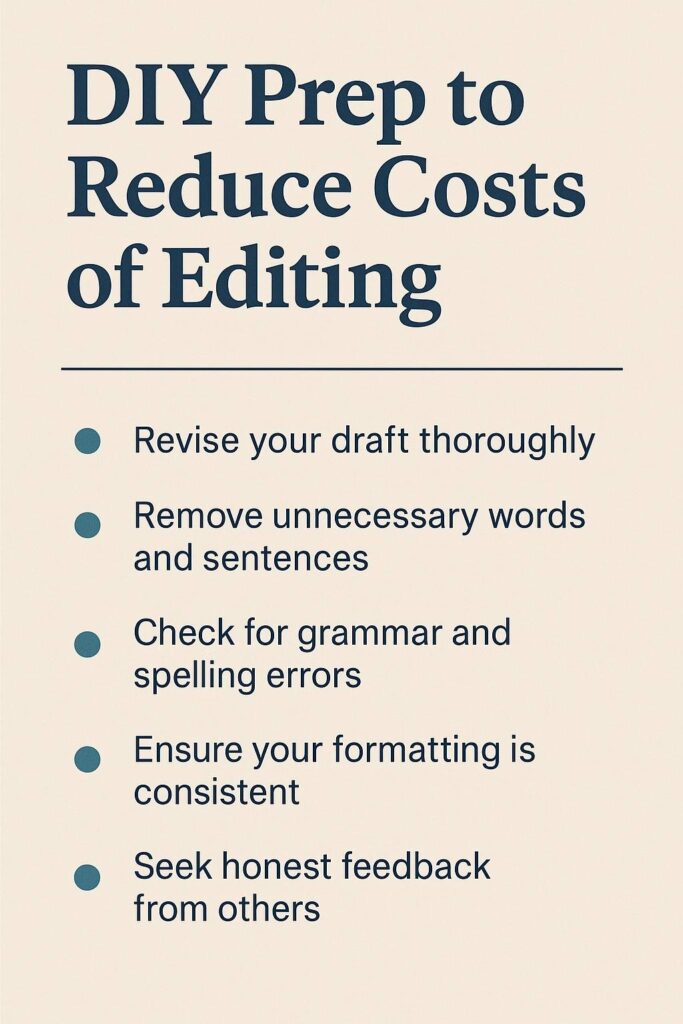
How to Choose the Right Editor
Why the right fit matters
Not every editor is right for every author. You can hire someone with an impressive résumé and still find their approach clashes with your vision. Editing is not just a technical process, it is also a creative partnership. You need someone who understands your genre, respects your voice, and communicates clearly.
Look at their portfolio
The first step is checking whether they have experience in your genre. An editor who shines at academic non-fiction may not be the best choice for a fantasy epic. Browse their past projects, testimonials, and case studies. Do the books they worked on look like the kind of book you want to publish?
Ask for a sample edit
Most professional editors offer a short sample edit on a few pages of your manuscript. This is invaluable. It shows you how they approach your work and lets you judge whether their comments are useful and respectful. It also gives them a chance to gauge how much effort your manuscript will require.
Be clear on scope
Remember the overlap in editing terminology. Some editors combine line and copyediting, while others separate them. Do not rely only on the labels. Ask directly what the service includes. Will they comment on story structure? Will they rephrase clunky sentences? Will they only correct grammar? A good editor will be transparent about exactly what they will and will not do.
Set expectations
Before hiring, clarify the deliverables and the schedule. How many rounds of feedback are included? How quickly will they return the manuscript? What format will you receive: a tracked Word document, a style sheet, a marked PDF? Make sure everything is clear in writing before the work begins.
Build the team you need
Editing is one part of the publishing process. Depending on your goals, you may also need professional book formatting services, cover design, or marketing support. Choosing an editor who understands where their role begins and ends helps you avoid confusion and keeps the process smooth.
The takeaway
The best editor for you is not simply the cheapest or the one with the longest list of credentials. It is the one whose skills, communication style, and expectations align with yours. Take the time to ask questions, compare samples, and make sure you feel comfortable. Your book deserves an editor who not only sharpens it but also respects the story you are trying to tell.
FAQs
1. What are the four main levels of book editing?
The four core stages are developmental editing, line editing, copyediting, and proofreading. Each one builds on the last, moving from big-picture story structure to fine detail.
2. In what order should the book editing happen?
Always follow the sequence: developmental first, then line editing, then copyediting, and finally proofreading. Skipping ahead usually means wasted money and missed opportunities to strengthen the manuscript.
3. What is the difference between line editing and copyediting?
Line editing focuses on style, voice, rhythm, and clarity at the sentence level. Copyediting enforces correctness by checking grammar, punctuation, usage, and consistency. Both matter, but they serve different purposes.
4. Is an editorial assessment the same as developmental editing?
No. An editorial assessment is a lighter report on strengths and weaknesses. It is useful if you want an overview before investing in a full developmental edit, but it will not give the same depth of feedback.
5. When should I proofread during book editing?
Proofreading comes last, only after copyediting and typesetting. It is the final sweep for typos, layout errors, and surface-level mistakes.
6. Do all books need all four levels of book editing?
Not always. Some manuscripts are already strong and may only need copyediting and proofreading. Others need all four. The right path depends on your draft’s readiness and your budget.
7. How much will book editing cost?
Costs vary by level, word count, and the quality of your draft. Most editors charge per word. Developmental and line editing are usually the most expensive, while proofreading is the least. Always gather multiple quotes.
8. How long does each level of book editing take?
It depends on length and scope. Developmental edits can take weeks or months, especially with multiple rounds. Line edits take a few weeks. Copyediting is faster, and proofreading is usually the quickest.
9. Can line and copyediting be combined?
Some editors bundle them, but you should clarify the scope. Make sure that style and flow do not overshadow correctness, or vice versa.
10. What do I receive from a developmental edit?
You will usually receive an editorial letter, margin notes throughout the manuscript, and sometimes a revised outline or follow-up call.
Conclusion
Editing is not one hurdle to clear. It is a journey with stages, each one designed to make your book stronger than the last. Developmental editing strengthens the foundation. Line editing shapes the sentences until they sing. Copyediting enforces correctness and consistency. Proofreading sweeps up the last surface errors so the book is ready for readers.
The mistake many authors make is thinking they can skip steps. But every stage has a purpose, and the four levels of book editing exist to protect both your story and your readers’ experience. Follow the sequence, and your manuscript grows sharper, clearer, and more professional at every turn. Ignore it, and you risk releasing something unfinished into the world.
Wherever you are in your draft, take a step back and ask yourself: What does my book need right now? Structure? Style? Accuracy? Or the final polish? Once you answer that honestly, you will know exactly which level is your next move. Editing can feel overwhelming, but it does not have to be. With the right knowledge and the right editor, it becomes a process of transformation. Page by page, draft by draft, your book will evolve into the version you always hoped it could be.

